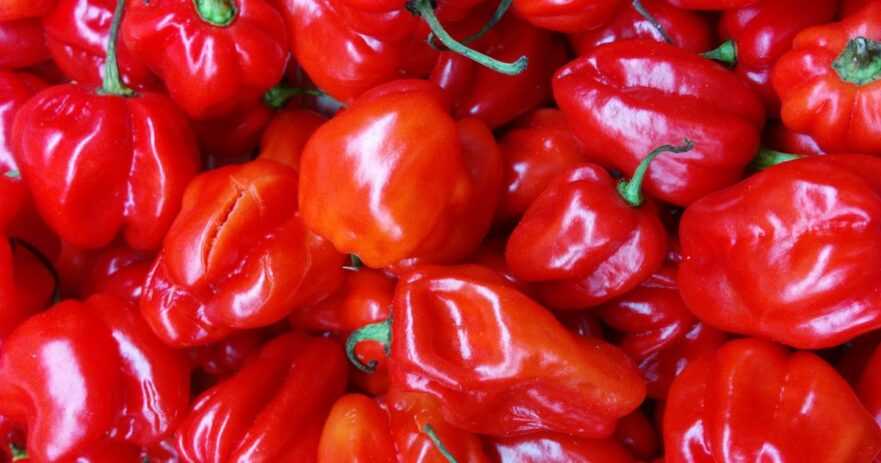In this article about scotch bonnet pepper:
🗺️ Origin and history | 🌶️ Uses | ✨ Appearance and taste | 🌶️ Types | 🧑🌾 Growing – gardening | 👨🍳 Cooking – recipes | 🛒 Where to buy | 🫙 How to store | 👨⚕️ Health benefits | 🌶️ Alternatives and substitutes | ❓ Frequently asked questions
What is a Scotch Bonnet pepper?
A fiery variety of chili peppers, Scotch Bonnets are well-known for their spice, heat, yet slightly sweet flavor. They received their name from a resemblance to a tam o’shanter (a Scottish cap). Though unlike most tam o’shanters’ coloring, Scotch Bonnets can be vibrant red, orange, or yellow.
Many cuisines utilize Scotch Bonnets as an integral ingredient, especially dishes from the Caribbean, as they give a spicy kick and distinct flavor to enhance a dish. Typically incorporated into marinades, hot sauces, or flavorful stews, these peppers add a great element to a meal.
| Scotch bonnet | |
| SHU | 100,000 - 350,000 |
| Median SHU | 225,000 |
| Flavor | Sweet, fruity, tropical, citrusy |
| Species | Capsicum chinense |
| Origin | South America |
| Uses | Sauces, dry rubs, marinades, salsas, soups, curries |
Are Scotch Bonnet peppers spicy? How hot are they?
Scotch Bonnet pepper scoville: 100,000 to 350,000 SHU
On the Scoville scale, Scotch Bonnet peppers range from 100,000 to 350,000 heat units. They definitely include a significant spiciness with their high ranking on the heat scale. Scotch Bonnets are recommended for individuals who enjoy an immense kick of heat.
Compared to other peppers, such as jalapeños (which range from 2,500 to 8,000 on the Scoville scale), Scotch Bonnets offer the consumer a much higher heat intensity. However, the spiciness of these peppers will vary, often depending on how ripe the pepper is and its conditions for growth. Generally speaking, as Scotch Bonnets mature, their heat intensifies and increases the fiery kick absorbed into a meal.
🗺️ ORIGIN AND HISTORY
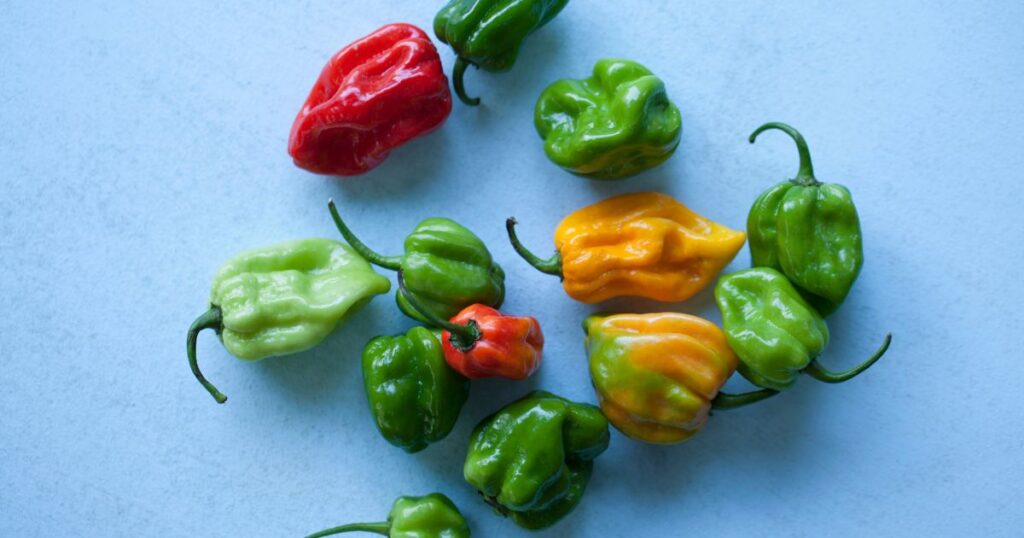
Where are Scotch Bonnet peppers from?
Originally located in the Caribbean, Scotch Bonnet peppers’ roots lie in their usage as a vital ingredient to Caribbean cuisine and heritage. Undoubtedly, these spicy peppers have been a staple in Caribbean meals for centuries, loved for their intense heat coupled with a slightly sweet and fruity taste.
Over time, Scotch Bonnets spread to other countries outside the Caribbean as they shared a similar enjoyment for their taste and spice. Now, most of these peppers are grown in tropical or subtropical regions, typically in Central America and Africa. They are shared globally through trade and enjoyed by adventurous, heat-loving eaters.
🌶️ USES
How to use Scotch Bonnet peppers
The Scotch Bonnet pepper is widely used in multiple culinary offerings with its heat and subtly sweet flavor. Many times, the peppers are incorporated into hot sauces, pickles, dried spices, or powders. They provide an intense kick to the dish in whatever manner they are used.
Due to its bold heat and mild tang, this pepper is often used in a Scotch Bonnet pepper sauce. The sauce is easily transferred to many meals, including as a sandwich topping or a chicken wing sauce selection. The spicy sauce will complement a variety of dishes.
Another popular use of these peppers is to create pickled Scotch Bonnets. While the pickling does not entirely eliminate their heat, pickling gives an additional tanginess to complement the spicy kick within the pepper. Use pickled peppers as a condiment for sandwiches, burgers, or even as a pizza topping. Dishes that lack a distinct flavor will benefit from adding Scotch Bonnet peppers.
Sometimes a dish will call for a spice rather than a chili pepper itself. If this is the case, dried Scotch Bonnet pepper, whether whole or ground into a powder, may be the perfect ingredient to lend a spicy kick to your meal. Grilled meats, stews, and soups gain the spicy, sweet flavor of Scotch Bonnets due to the concentration of the pepper’s flavor during drying. In addition, this pepper powder will vastly enhance the flavors of a dish as it gives it the heat and slightly fruity flavor needed.
Finally, marinades incorporating Scotch Bonnet peppers will offer heat in their dishes that are often not met with milder peppers. This will satisfy any spicy kick lover.
✨ APPEARANCE AND TASTE
What do Scotch Bonnet peppers look like?
Scotch Bonnet peppers most often resemble the Scottish tam o’shanter hat. This distinct look lent them the name “Scotch Bonnet.” These chilies are small, typically only around 1 to 2.5 inches long and 1 to 2 inches in diameter. With smooth skin, they showcase vibrant colors that range from green, yellow, orange, and red.
How do Scotch Bonnet peppers taste?
While Scotch Bonnet peppers are hotter than most peppers, a sweet, slightly fruity flavor can also be detected. The first bite will allow you to taste the sweeter taste, then the spicy kick quickly takes over and lingers. Heat-loving eaters will enjoy Scotch Bonnets as they appreciate the heat and complexity of the pepper’s flavor.
🌶️ TYPES
What are the different types of Scotch Bonnet peppers?
With their distinct Scottish cap shape and intense spice, Scotch Bonnet peppers are available in various colors, each offering a unique taste. You may find either the red, yellow, green, orange, or chocolate variants.
Red Scotch Bonnet peppers are the most recognized type, as they are deep red and deliver intense heat. These peppers balance a fruity flavor with the spice, adding a unique flavor and kick to meals.
Yellow Scotch Bonnet peppers are known for their vibrant yellow color, and while they still give a great kick of heat, their underlying flavor is more tropical and sweeter. Typically used in Caribbean and Jamaican dishes, they enhance both flavor and aesthetic with their bright color.
Green Scotch Bonnet peppers are not as mature as other variations. These are typically younger and less hot, offering a slightly tangier and far less sweet flavor. They do not have as intense of a heat level. These green peppers are great for dishes where less heat is called for or wanted.
Orange Scotch Bonnet peppers land between their green and red counterparts as a middle ground with their bright orange color. Subtly sweet and giving a spicy kick to a dish, they are a great choice for those who want a pepper that is not on one of the spectrum’s extremes.
Lastly, the least common variant is the chocolate Scotch Bonnet identified by its deep brown or chocolate color. Contrary to its sweet name, chocolate Scotch Bonnets pack a strong punch of heat and a rich, slightly smoky flavor, unlike the sweetness in the other variants.
🧑🌾 GROWING – GARDENING
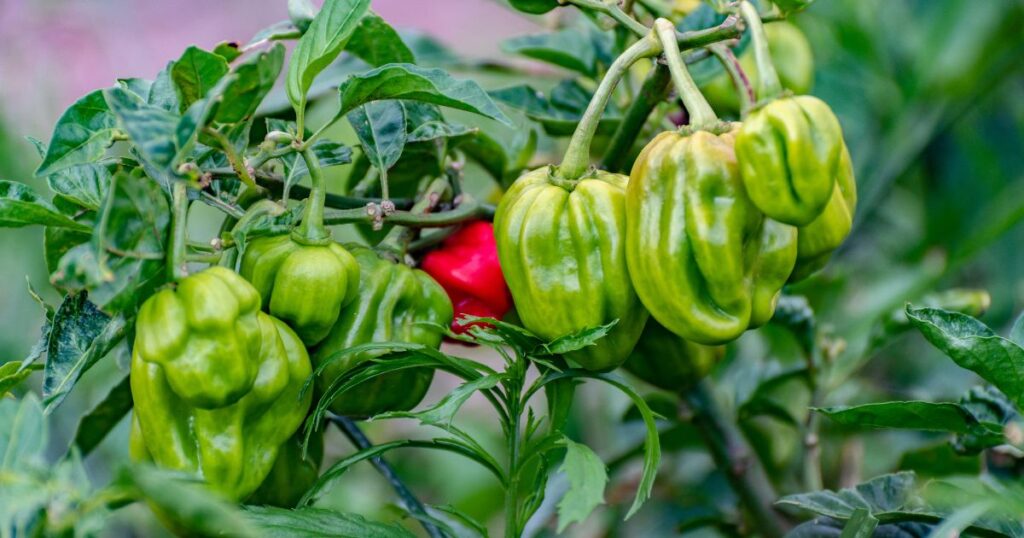
How to grow Scotch Bonnet pepper
Gardening enthusiasts love to grow Scotch Bonnet peppers. Flourishing in warm, sunny climates can be grown in garden beds or containers. Crucial to their growth is well-draining soil and consistent watering. Add fertilizer regularly, and these peppers will most likely thrive.
When to pick Scotch Bonnet peppers
Depending on their growing conditions, Scotch Bonnet peppers will generally take 90-120 days to fully mature. Regular harvesting throughout the growing season will benefit the plants and cause them to produce more peppers. Patience may be needed while growing these peppers as their maturation period is slightly longer than other peppers. However, the harvest will yield the perfect, vibrant, spicy peppers as a reward.
👨🍳 COOKING – RECIPES
Cooking/Recipe ideas for Scotch Bonnet peppers
Scotch Bonnet peppers can be used in various dishes to add a fiery kick to almost any meal. One of the most popular uses is the creation of Scotch Bonnet pepper hot sauce, giving a kick to any food that incorporates it, whether during breakfast, lunch, or dinner. Making his hot sauce involves pureeing the peppers with garlic, onion, vinegar, and a hint of sugar or honey. As a result, the sauce will be well-rounded in flavor, spicy, and versatile – the perfect condiment to add to many meals.
Scotch Bonnet pepper powder will rapidly become a go-to spice in your repertoire as you can add the Scotch Bonnet peppers’ heat and flavor to your dishes in the desired amount. Often used for seasoning meats, veggies, or on top of popcorn, just remember that a tiny amount can pack a big kick of heat!
Scotch Bonnet jelly blends the sweetness of fruit preserves and the fiery heat of the peppers. This jelly is great on top of warm toast, cream cheese, and crackers or as a glaze on various types of meat. The sweet and spicy combination will taste delicious to lovers of bold flavors.
A final popular usage of Scotch Bonnet peppers is in stews or curries inspired by Caribbean dishes. This meal combines peppers with other vegetables or protein-rich foods, then simmered in a rich sauce. A comfort food for many, the hearty yet spicy dish is guaranteed to taste delicious.
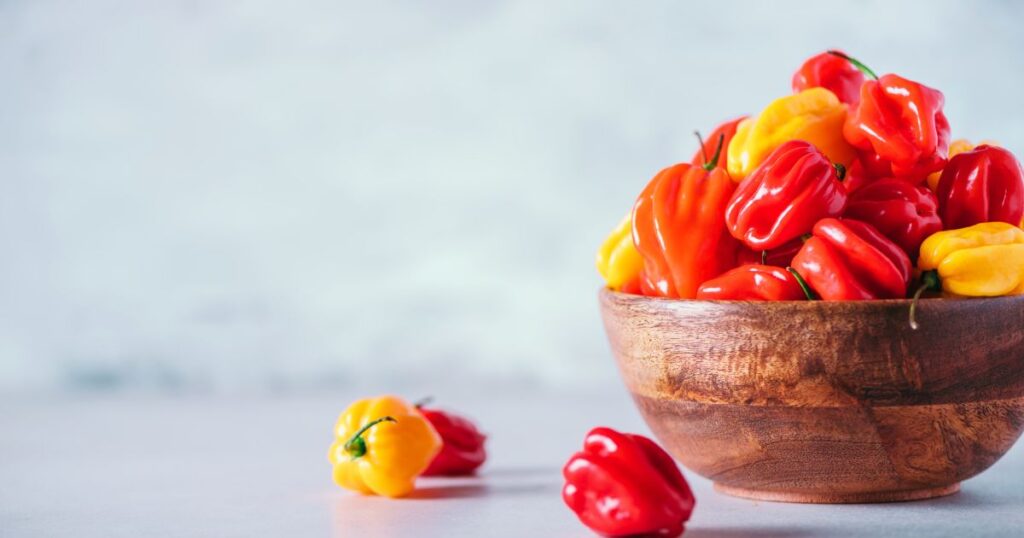
🛒 WHERE TO BUY
Where can I buy Scotch Bonnet peppers?
Often found in grocery stores, Scotch Bonnet peppers are offered fresh and dried and may be located in stores specializing in exotic or international foods. Farmers’ markets and ethnic grocery stores are also excellent places to seek out these peppers. Of course, if you are unable to find them locally, try giving them a search online. Many suppliers will ship Scotch Bonnet peppers right to your door.
To purchase perfect Scotch Bonnet peppers, ensure they are firm and have bright colors. Avoid any that are soft, wrinkled, or have dark spots, as these may be beyond ripeness.
Scotch Bonnet peppers may be found in various other food products, including hot sauces, powders, or pickles. Generally, these foods are found in the condiment or spice sections of grocery stores, or online.
Where can I buy Scotch Bonnet pepper plants?
Garden centers, nurseries, and online plant suppliers will offer Scotch Bonnet pepper plants for purchase. When selecting a plant, look for one that appears in good health, as evidenced by strong stems and a rich green color on its leaves. Any wilted plants or yellow leaves may not be the healthiest selection.
Where can I buy Scotch Bonnet pepper seeds?
Scotch Bonnet pepper seeds can be purchased from local garden centers or through online retailers. For gardening enthusiasts who love to start from the ground up, Scotch Bonnet pepper seeds are a great start in this process. Just remember, the plants will want lots of sunlight, well-drained soil, and watering to thrive. Also, follow any additional instructions on the seed packet.
🫙 HOW TO STORE
How do I store Scotch Bonnet pepper?
Scotch Bonnet peppers can be stored fresh in the refrigerator for approximately up to two weeks. To help prolong their shelf life, put them in a plastic Ziploc bag or a container with an airtight seal, then store them in the crisper drawer.
To preserve dried Scotch bonnet peppers or products already created with them, store in a dry, cool location out of direct sunlight. Airtight containers can maintain freshness and protect against moisture for optimal usage.
Can Scotch Bonnet peppers be frozen?
Scotch Bonnet peppers can be frozen and used at later times. First, wash the peppers and remove their stems, then place them in a single layer on a baking sheet and freeze for a few hours. Once they are fully frozen, take them and put them inside an airtight container or freezer-safe plastic bag. Store in the freezer for up to six months and use as needed for upcoming cuisine that needs a kick of heat.
❤️🩹 HEALTH BENEFITS
Are Scotch Bonnet peppers healthy?
Scotch Bonnet peppers do carry many health benefits with their nutritional value. They are low in calories, fiber-rich, and contain many essential vitamins and minerals, such as vitamin C, vitamin A, and potassium. High amounts of vitamin C in these peppers may increase your immune system, promote skin health, and enhance your overall well-being.
Also, a source of capsaicin, the compound responsible for their intense heat, Scotch Bonnet peppers may provide additional benefits. Capsaicin is known for its anti-inflammatory and pain-relieving properties and may assist in boosting one’s metabolism. However, it is important to know that capsaicin can cause gastrointestinal discomfort for some people. Therefore, if you experience discomfort after eating a dish with Scotch Bonnet peppers, we recommend you limit or halt your consumption of the peppers.
🔄 ALTERNATIVES AND SUBSTITUTES
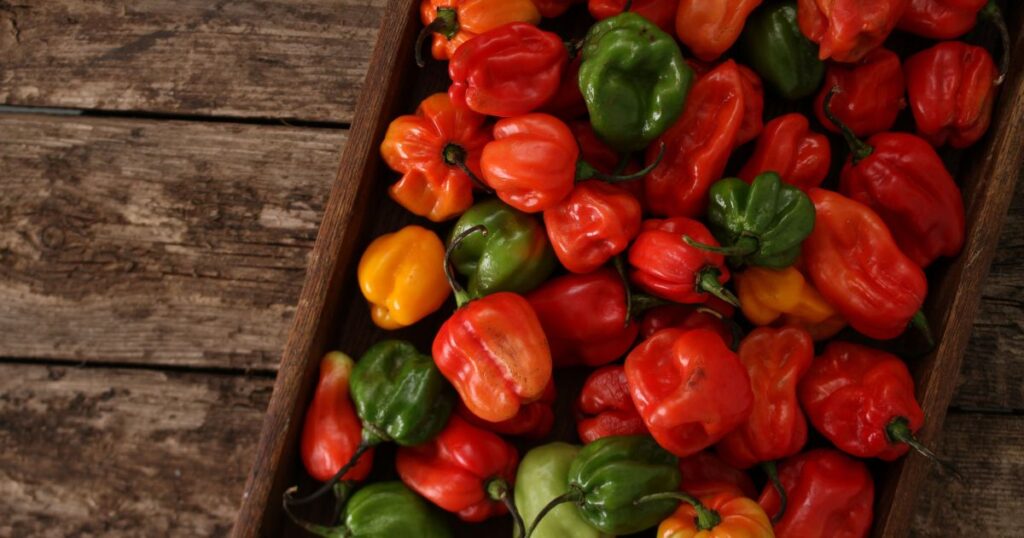
What is a good alternative to Scotch Bonnet pepper?
Habanero peppers have a flavor and heat level similar to Scotch Bonnet peppers, so they are an excellent substitute. Both peppers give a similar fruity flavor with a sharp kick; they are often interchangeable in recipes that call for a fiery pepper.
For those who want less spice, jalapeño peppers may be ideal. Though they still offer a kick, it is significantly less spicy than Scotch Bonnets. If the preference is for milder heat, jalapeños are a great substitute. Similarly incorporated into a variety of recipes, like salsas and sauces, their heat can be reduced by removing the seeds and inner membranes of the peppers.
Serrano peppers sit in the middle of the spectrum for their heat levels. While they give a greater kick than jalapeños, they are less spicy than Scotch Bonnets. However, like Scotch Bonnet peppers, they are versatile, utilized in salsas and sauces, and often pickled.
How do you pronounce Scotch Bonnet?
Scotch Bonnet is pronounced as SKOTCH BON-it.
🙋 FREQUENTLY ASKED QUESTIONS
FAQ about scotch bonnet peppers
Are Scotch Bonnet peppers hot?
Absolutely, Scotch Bonnet peppers are pretty hot. They range from between 100,000 and 350,000 units on the Scoville Heat Scale, boosting them to the top as one of the hottest peppers available. Known for their intense heat, they are balanced with a slightly sweet and mildly fruity taste. A staple in Caribbean dishes, they provide a spicy kick for heat lovers.
Are Scotch Bonnet pepper plants perennial?
Scotch Bonnet pepper plants are technically perennial, so they can potentially can grow year-round. However, their perennial nature often depends on the climate they grow in. In warmer climates, they can survive and produce peppers for several years. On the other hand, in cooler climates, they are often grown annually as the plant dies during the winter and needs replanting in the spring.
Can Scotch Bonnet peppers be frozen?
Yes, Scotch Bonnet peppers can be frozen and used over a prolonged period of time. This is a great way to preserve their heat and flavor. Just wash the peppers, remove their stems, and place them in a single layer on a baking sheet inside the freezer. Once frozen, transfer them into an airtight container or freezer bag and store in the freezer. Scotch Bonnet peppers can be kept for up to six months when frozen.
Are Scotch Bonnet peppers the same as habanero peppers?
Commonly confused, Scotch Bonnet peppers and Habanero peppers are not the same, despite a similar appearance and heat intensity. Both peppers have an exceptional spice and similar fruity, sweet flavors, though Scotch Bonnets taste a bit sweeter. They also have subtle differences in shape, the most obvious being a Scotch Bonnet pepper’s resemblance to a Scottish cap.
What color of Scotch Bonnet pepper is the hottest?
Generally, the hottest Scotch Bonnet peppers are fully ripe, typically appearing in red or orange. Similarly, as most peppers, their heat intensifies as they mature. However, this heat can vary among peppers of the same color, depending on the plant's genetics and growing conditions. Though red and orange Scotch Bonnets are most likely hotter than other colors, the green variant also carries a great kick of spice.
